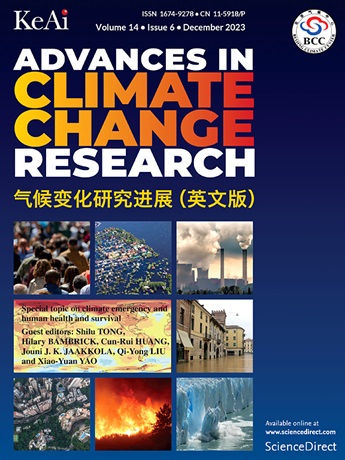Land–atmosphere feedbacks weaken the risks of precipitation extremes over Australia in a warming climate
IF 5.2
1区 地球科学
Q1 ENVIRONMENTAL SCIENCES
引用次数: 0
Abstract
The importance of land–atmosphere feedbacks on regional precipitation changes has been recently noted. However, how land–atmosphere feedbacks shape daily precipitation distributions, particularly the tails of precipitation distributions associated with extreme events, remains unclear on a regional scale. Herein, using the latest land–atmosphere coupling experiments, this study reveals a consistent weakening effect of land–atmosphere feedbacks on the future increase in precipitation extremes over Australia, revealing the most pronounced reduction (56.8%) for the long-term (2080–2099) projection under the low emission (SSP1-2.6) scenario. This weakening effect holds true for shifts in the extreme tail of precipitation distribution, resulting in a reduced risk of precipitation extremes in a warming climate. Land‒atmosphere feedbacks offset 28%–60% of the occurrence risk for the 99th percentile of daily precipitation, with the largest reduction of 172% when precipitation exceeds the 99.7th percentile in the long-term projection under the high emission (SSP5-8.5) scenario. Considering less water replenishment, these feedbacks may reduce the risk of flooding but potentially expedite droughts, highlighting the role of land–atmosphere feedbacks in extreme event projection and regional climate adaptation.
在气候变暖的情况下,陆地-大气反馈削弱了澳大利亚极端降水的风险
最近,人们注意到陆地-大气反馈对区域降水变化的重要性。然而,在区域尺度上,陆地-大气反馈如何形成日降水量分布,尤其是与极端事件相关的降水量分布尾部,仍不清楚。在此,本研究利用最新的陆地-大气耦合实验,揭示了陆地-大气反馈对未来澳大利亚极端降水量增加的持续减弱效应,在低排放(SSP1-2.6)情景下,长期(2080-2099 年)预测降水量的减弱最为明显(56.8%)。这种减弱效应适用于降水分布极端尾部的变化,导致气候变暖时极端降水的风险降低。在高排放(SSP5-8.5)情景下的长期预测中,当降水量超过 99.7 百分位数时,陆地-大气反馈抵消了 28%-60% 的日降水量第 99 百分位数发生风险,最大降幅为 172%。考虑到较少的水分补充,这些反馈可能会降低洪水风险,但有可能加快干旱的发生,突出了陆地-大气反馈在极端事件预测和区域气候适应中的作用。
本文章由计算机程序翻译,如有差异,请以英文原文为准。
求助全文
约1分钟内获得全文
求助全文
来源期刊

Advances in Climate Change Research
Earth and Planetary Sciences-Atmospheric Science
CiteScore
9.80
自引率
4.10%
发文量
424
审稿时长
107 days
期刊介绍:
Advances in Climate Change Research publishes scientific research and analyses on climate change and the interactions of climate change with society. This journal encompasses basic science and economic, social, and policy research, including studies on mitigation and adaptation to climate change.
Advances in Climate Change Research attempts to promote research in climate change and provide an impetus for the application of research achievements in numerous aspects, such as socioeconomic sustainable development, responses to the adaptation and mitigation of climate change, diplomatic negotiations of climate and environment policies, and the protection and exploitation of natural resources.
 求助内容:
求助内容: 应助结果提醒方式:
应助结果提醒方式:


